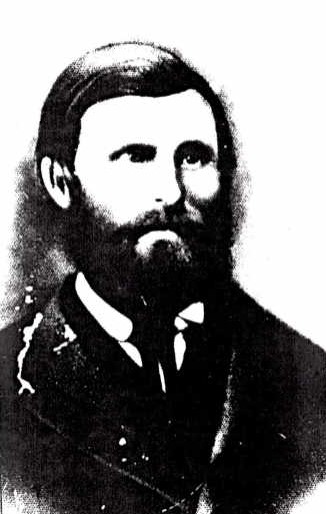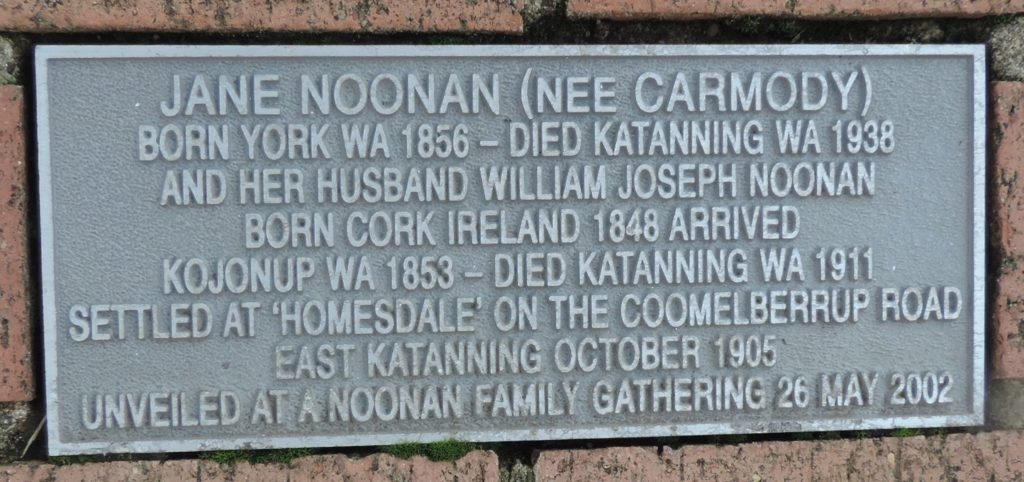Noonan

William David Noonan was born at Glenburham, Kilmallock in Ireland in 1808 and died at Kojonup, Western Australia on 29 April, 1862. He married Eleanor Nora O’Donnell in January of 1841 at Marylebone, London in England and the couple migrated to Western Australia arriving in Fremantle on 13 January, 1853.
A son, William Joseph Noonan, was born 1848 in Ireland, before the couple departed Ireland, and he died in Katanning in 1910. William married Mary Jane, the daughter of Patrick and Mary Carmody in York in 1878, and they made their home at “Muringellup“, near “Mean Mahn“, four miles to the east of Katanning.
Mary Jane had moved to Kojonup with her family in 1874 at the age of 18 years where she met William. Eventually their near neighbour, Mr. Eli Quartermaine, purchased Muringellup with the Noonan’s passing the intervening period until 1905 at Roebourne, Albany, Geraldton and Fremantle.
In the latter year they returned to the Katanning district to take up the farming property known as “Homesdale,” where they resided with their family until a few years before Jane’s death, who died in Perth in 1938, Perth aged 82 years. William pre-deceased his wife dying in Katanning in 1910.
The couple had seven children; William David (1879 – 1916), Margaret Elizabeth (1883 – ), Michael Richard Barry (1884 – 1940), Ethel Mary (1886 – ), Francis Joseph Patrick (1888 – 1952), Gerald Emmett (1890 – 1969), and Anne Delores (1893 – 1970). Their son, William David Noonan, was killed in action on 5 August, 1916 and is buried at Villers-Bretonneux in France.
William David & Eleanor Nora Noonan
(Father of William Joseph Noonan)

William David Noonan was born at Glenburham, Kilmallock in Ireland in 1808 and died at Kojonup, Western Australia on 29 April, 1862. He married Eleanor Nora O’Donnell in January of 1841 at Marylebone, London in England and the couple migrated to Western Australia arriving in Fremantle on 13 January, 1853.
William joined the army (54th Regiment) in Chatham, England, in 1826 and, in 1827, left for India and may have had his wife Eleanor with him. His army records show he spent much time in hospital and he was discharged for ill-health in 1848 and that he would receive a pension of one pound per diem (Latin for ‘per day’). In 1848 he enrolled in the Pensioner Guard and was stationed in North London District.
He and Eleanor left Ireland with their children, arriving in Fremantle on 13 January, 1853 Australia aboard the Travancore as an Enrolled Pensioner Guard and were sent to Kojonup. Their five children were: Mary Harris (born Noonan) 1837-1887, Bridget Mary Grover (nee Noonan) 1842-1926, William Joseph Noonan 1848-1910, Eleanor Alice Cronin (nee Noonan) 1849-1885, and Margaret Elizabeth Norrish (nee Noonan) 1850-1930.
The town of Kojonup was founded in 1827 as a Military outpost to shelter travellers as they journeyed from Albany to the Swan River Colony (Perth). Many of the earlier families were those of Pensioner Guards – men who had served in the British army, pensioned off and then re-employed to transport convicts to Western Australia in the 1850’s.
One such family was that of William and Eleanor Noonan. In 1855, Eleanor decided her twelve-year old daughter Bridget needed an education beyond that which she could provide.
In Fremantle, about 270 kilometres away, was a school run by some Roman Catholic sisters. Loading their belonging on a mail cart, Eleanor and Bridget started to walk. Each day they would leave before the cart, and would arrive at its stopping place late in the evening. It is known that Eleanor made this walking trip several times, once at the beginning of the year to take her girls to Fremantle, and then at the end of the year to bring them home again.
This story, amazing as it is, would have slid quietly into history unnoticed except that her first journey was interrupted by a murder. A mentally ill criminal was on the mail cart, being escorted to Fremantle. At the changeover of police, this man acquired a rifle and shot one policeman dead. The other ran for assistance and returned to re-capture him. The policeman was buried and the journey continued.
On her return home, alone and again on foot, Eleanor discovered the grave had been disturbed by wild dogs, so she re-buried the policeman and placed large boulders on the grave. As one travels along the Albany Highway, near a small settlement of Bannister, one can still see this grave, suitable marked.
Death of Mrs. Jane Noonan
The Passing of a Pioneer Woman.
Great Southern Herald
30 November, 1938
On November 18th, 1938,at the residence of her daughter, Mrs. J. F. McEnroe in South Perth, there passed away Mrs. Jane Noonan (nee Carmody), of “Homesdale,” East Katanning, aged 82 years. Her husband, the late W. J. Noonan, had predeceased her 28 years previously.
The death of Mrs. Noonan severs a link with the very early days of Western Australia and, particularly, this district. Her parents, Mr. and Mrs. P. Carmody, came to this State from Ireland by the sailing ship Palestine in 1853, proceeding to York, where their daughter Jane was born in 1856.
She spent her childhood in the district, throughout which she became very popular with the scattered residents, leaving at the age of 18 with her parents for Kojonup in 1874. Four years later she was married to Mr. W. J. Noonan with the wedding taking place at York in 1878 before the young couple made their home at Muringellup, near Mean Mahn, four miles to the east of Katanning.
Eventually their near neighbour, the late Mr. Eli Quartermaine, purchased Muringellup, with the Noonan’s passing the intervening period until 1905 at Roebourne, Albany, Geraldton and Fremantle. In the latter year they returned to the Katanning district to take up the farming property known as “Homesdale,” where they resided with their family until a few years before Jane’s death.
Mrs. Noonan possessed a fund of anecdote and reminiscences of the early days, when the sandalwood industry was at its zenith and sandalwood and wool were the only marketable products. Once, or twice a year at the most, those pioneer settlers made a trip to Albany for stores, carrying down by box dray or wagon the sandalwood and wool to be exchanged for foodstuffs and raiment (clothing) sufficient to last until the next trip.
The same heavy conveyances were used for the infrequent visits to York and Perth, weeks being spent on these lonely trips over rough, unmade roads and through practically uninhabited country. Then followed the coaching days, with spanking teams of horses drawing the coach along the Albany-York road at speeds undreamed of in the earlier period, with the Chipper brothers on the box seat of the weekly mail coach.
Finally, the greatest achievement of all came the Great Southern Railway in 1889 with Mrs. Noonan, as a proud mother of a growing family, one of the first passengers to travel on the train.
In the short period of 33 years she had seen the young State taken in hand by a small band of indomitable pioneers and transformed from an unpopulated wilderness to something approaching civilisation; she had experienced the rough life of the bush with her parents and then her husband, and had witnessed the progress in transport from heavy dray over unmade tracks to a modern railway.
Mrs. Noonan lived long enough in the district to experience the change from riding long miles on horseback to visit the nearest womenfolk to making similar visits in comfort by motor car. Although she never travelled by one, she lived long enough to see aeroplanes in daily use as a means of transport.
Her remains were laid to rest in the Katanning Cemetery on Sunday, November 20, 1938, after the celebration of Requiem Mass at St. Patrick’s Church, Katanning, by the Rev. Father Byrne, who also conducted the service later at the graveside, amidst a large gathering of relatives and friends. The coffin was followed as chief mourners by Messrs. J. H., M. R. B., J. F. P. and G. E. Noonan (sons), Mrs. J. F. McEnroe (daughter), W. H. Noonan (grandson), Mrs. W. P. Taylor, Netta Noonan, E. Noonan, Marie, Ron. and Frances McEnroe (grand-daughters), Mr. F. J. McEnroe (son-in-law), Mrs. F. J. P. Noonan and Mrs. M. R. Noonan (daughters-in-law), and Mrs. W. H. Noonan (grand-daughter-in-law). Her pall-bearers were Messrs. J. F. Haddleton, F. M. Bowden, G. Barker, J. Fraser, W. E. Richmond and F. L. Cruickshank.
Amongst those present at the funeral were the following: –
O’Neil, W. Haddleton, W. J. Kelly, B. F. Kelly, E. W. Flugge, A. L. Flugge, W. E. Flugge, C. H. Flugge, J. C. Antonio, H. Matthews, F. J. Carlson, C. R. Norrish, A. G. Purkiss, J. Clancy, M. S. Cornelius, T. O’Connor, J. Sheehan, P. J. McAuliffe, G. J. Cornelius, W. D. Grover, R. A. Ferguson, F. Norrish, T. J. Clune, E. Piesse, J. B. Cornelius, E. M. Cronin, R. C. Meyn, D. Coffey, J. Walsh, C. Cronin, S. R. Hedditch, W. E. Cronin, R. Matthews, J. R. Tunney, L. Haddleton, F. J. Gully, H. C. Ainsworth, E. C. Jones, F. Cronin, S. Dwyer, E. Stapleton Snr., T. Hall, N. C. Flugge, Les. Holly,
H. Harken, E. S. Luscombe, J. Stapleton, J. Clancy, H. Baker; Mesdames J. R. Tunney, W. C. Cronin, K. Cruickshank, J. Haddleton, J. Stapleton, A. Keeley, H. J. Bradbury, C. Fitzgerald, E. S. Luscombe, N. C. Flugge, G. Graham, F. L. Cruickshank, J. E. Walter, W. J. Kelly, J. Cornelius, J. Clancy, H. Harken, L. Holly and Misses M. Roberts and J. Walter.
Wreaths were received from Mrs. F. L. Cruickshank, Mrs. A. M. Keeley, Mrs. Layton, Minerva, Vic. and Myra, Mrs. M. J. Garrity and Matron Ross, Frank (Glencoe), Jack, Edith and Boys, The Purkiss Family, Gwen. and Cliff. Robertson, All at Indinup, Katanning Sub-Branch R.S.L., Directors of Richardson and Co. Ltd., Mrs. Duttson and family, Eddie and Myra, Mr. and Mrs. W. Longmire.
.
Death of Bridgette Mary Grover (nee Noonan)
A PIONEER PASSES.
The Late Mrs. B. M. Grover.
Western Mail
16 August, 1926
With the death, on August 13, at the age of 84 years and three months, of Mrs. Bridget M. Grover, of Indinup, Katanning, the State lost one of the few remaining links with its earliest history.
Mrs. Grover, directly and also in association with her husband, the late William Grover, was connected with the very first settlement of the Kojonup district, as she came to what is now Kojonup in 1850, seventy-six years ago, when her father, Sergeant Noonan, as an Imperial soldier, was sent there with a detachment, to keep in check the turbulent natives, and to afford some protection to the royal mail from Albany to Perth. She was then eight years of age, having been born in 1842 in Dublin, Ireland. Continue reading

Pioneer Heritage Wall – Katanning
FURTHER READING
A LONELY GRAVE.
A Policeman and a Lunatic.
The reference appearing recently in “The West Australian” to a grave at the side of the Perth-Albany road near the Bannister recalls the story of a grim happening of nearly 80 (165 years in 2022 ed.)years ago and also of the courage and fortitude of the women pioneers of those early days.
Continue reading
ABOUT THE PENSIONER GUARD
Research the Enrolled Pensioner Guards Here and Here
Read about the Enrolled Pensioner Guards at Kojonup Here
Read about Elverd’s Cottage, Kojonup Here
